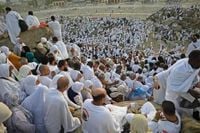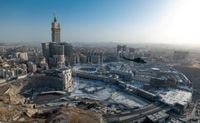On June 5, 2025, millions of Muslims worldwide marked the Day of Arafah, a pivotal moment in the Islamic calendar and the spiritual climax of the annual Hajj pilgrimage. This sacred day, falling on the 9th of Dhul Hijjah—the final month of the Islamic calendar—saw tens of thousands of pilgrims gather atop Mount Arafat, east of Mecca, while millions more observed fasting and prayer from their homes, including many in Eastleigh, Kenya.
In Saudi Arabia, the plains of Arafat transformed into a scene of profound devotion and reflection. Pilgrims clad in simple white garments known as ihram assembled before dawn at Jabal al-Rahmah, or the Mount of Mercy, the historic site where Prophet Muhammad (peace be upon him) delivered his Farewell Sermon over 1,400 years ago. This sermon, emphasizing justice, equality, mercy, and unity, remains a cornerstone of Islamic teachings.
The significance of this day is underscored by the revelation of a key Qur’anic verse at Arafat: “This day I have perfected for you your religion...” (Qur’an 5:3). For the pilgrims, standing from just before noon until sunset in a ritual called wuquf—literally “standing before God”—is both a symbolic rehearsal for the Day of Judgment and a deeply personal moment of repentance and supplication. As they raised their hands in prayer, recited verses from the Qur’an, and sought Allah’s forgiveness, the atmosphere was charged with spiritual intensity.
Sheikh Ebrahim Gabriels, Imam at Al-Masjidur Rawbie and director of the Al Quds Foundation SA, speaking live from Arafat, described the scene as filled with "deep spiritual emotion." He confirmed that all South African pilgrims had arrived safely and called on Muslims worldwide to embrace the blessings of the day, whether physically present or not. “As the Hujaaj are making tawbah here on Arafah (repentance), you must also make tawbah and cry in front of Allah, as He will forgive you,” Sheikh Gabriels urged, emphasizing the day’s promise of divine mercy and forgiveness.
Back in Eastleigh and other parts of Kenya, the Day of Arafah was observed through fasting, a voluntary but highly encouraged act of worship for Muslims not performing the Hajj. The usually bustling streets of Eastleigh were noticeably quieter on the morning of June 5, with fewer people on the roads and many shops remaining closed early in the day. Even restaurants that stayed open found themselves without customers, reflecting the solemnity of the occasion. According to Islamic tradition, fasting on this day expiates the sins of the past and coming year—a spiritual benefit echoed in the Prophet Muhammad’s words: “It expiates the sins of the past year and the coming year.”
Imam Tirmidhi, a respected Islamic scholar, also recorded the Prophet’s teaching that “there is no day on which Allah frees more people from the Fire than on the Day of ‘Arafah.” This belief imbues the day with a sense of hope and renewal, inspiring millions to seek forgiveness and spiritual cleansing.
Meanwhile, Saudi authorities faced the enormous logistical challenge of ensuring the safety and well-being of the 1.8 million pilgrims expected this year. Following the tragic heat-related deaths exceeding 1,300 during the 2024 Hajj, when temperatures soared to a deadly 51.8°C, officials implemented rigorous safety measures. Pilgrims were advised to remain in air-conditioned tents between 10 a.m. and 4 p.m. to avoid sunstroke, as daytime temperatures climbed above 40°C.
To mitigate the risks, Saudi Arabia mobilized over 250,000 personnel and expanded shaded zones by 50,000 square meters. More than 400 cooling stations were set up, along with thousands of health workers and advanced surveillance tools, including drones and AI-assisted crowd management systems. These efforts aimed to balance the spiritual sanctity of the pilgrimage with the practical necessity of protecting human life.
Security measures extended to regulating access to Mecca, with authorities intensifying operations to block unregistered pilgrims. Using drones, police raids, and mass text alerts, officials enforced strict permit regulations distributed globally through quotas and lotteries, aiming to prevent overcrowding and ensure that pilgrims had access to regulated accommodations and services.
As the sun set on Arafat, pilgrims prepared to move to Muzdalifah, a desert plain between Arafat and Mina, where they would collect pebbles for the symbolic stoning of the devil ritual, a key rite in the days leading to Eid al-Adha. This festival, celebrated in Saudi Arabia on June 6 and by South African Muslims on June 7, marks the culmination of the Hajj and commemorates the willingness of Ibrahim (Abraham) to sacrifice his son in obedience to God.
The spiritual ambiance of Arafat was enhanced by the recent completion of an extensive and modern lighting network by the Makkah Municipality. Installed with around 20,000 lighting units mounted on approximately 5,000 towers and poles, the system illuminated all streets and roads of Arafat. On the evening of Tarwiyah—the day before Arafah—the area was bathed in a breathtaking display of lights, heightening the pilgrims’ sense of reassurance and enhancing the sacred atmosphere.
These lighting installations were part of annual upgrades focusing on key areas, including pedestrian paths and routes linking Arafat to Muzdalifah and other important sites, ensuring that pilgrims could navigate safely during the night and early morning hours.
For many Muslims worldwide, the Day of Arafah is a moment of profound spiritual rebirth. Whether standing on the plains of Arafat, fasting in Eastleigh, or praying from homes across the globe, the day represents an opportunity for forgiveness, renewal, and unity within the Ummah. The collective chants of “Labbayk Allahumma Labbayk” (“Here I am, O Allah, here I am”) that echoed across Arafat have resonated for over a millennium, symbolizing the enduring devotion and submission of Muslims to their Creator.
As the world reflects on this sacred day, the balance of tradition, safety, and modernity in the Hajj pilgrimage continues to evolve, highlighting both the timelessness of faith and the challenges of contemporary pilgrimage management. The Day of Arafah remains a beacon of hope, mercy, and spiritual connection for Muslims everywhere.





